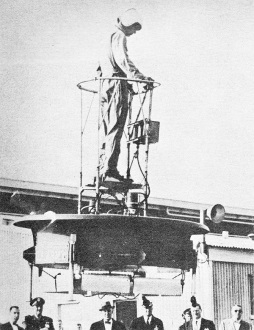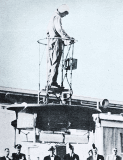|
A lot of wild and zany ideas
for flying machines have been tried over the years. Most, if not all, of them could
probably be coaxed into flying with modern computer-controlled stabilization and
navigations systems that use fast-reacting powerplants, sensitive accelerometers
and position sensors. For anything other than stable platforms, human pilots just
could not provide control - at least on an extended basis and under adverse weather
conditions. This "flying platform" by Hiller Helicopters is one such example. It
appeared in the May 1957 issue of American Modeler magazine. Piloting it
was essentially the same as with the Lunar Lander.
"Flying Platform" Gets Three Engines
 Photos and text by Howard Levy Photos and text by Howard Levy
Hiller Helicopters received $500,831 contract from U. S. Army for the production
of two prototypes of multi-engine "Flying Platforms." Similar in appearance to original
"Platform" unveiled in 1955 (powered by two Nelson 2-cycle engines developing 44-hp
each), new version is powered by three Nelsons. Design refinements developed after
extensive testing of the twin-engine prototype. In the 3-engine job pilot stands
higher over shroud. New airfoil sections appearing to be form of directional control
have been added under the shroud.
The "Flying Platform," an extremely simple and compact aircraft, employs ducted
fan principle of lift (shrouded props which gain lift by channeling air in combination
with directing flow of air over lipped orifice). The operator relies on body balance
and movement for inflight directional control.
Hiller feels that many variations of the "Flying Platform" are possible and that
large "Platforms" for long range and small ones for short range missions could be
successful. Field evaluation of the complete range of possibilities for the ducted
fan principle of lift in tactical applications will be an important part of the
Army test program.
 Flying Platform (Hiller Aircraft) Flying Platform (Hiller Aircraft)
Hiller Aircraft Corporation, founded by Stanley Hiller Jr., was indeed involved
in the development of various helicopters and unconventional aircraft, including
"Flying
Platforms." The Flying Platform was an experimental vertical takeoff and landing
(VTOL) aircraft that Hiller developed in the 1950s.
The Hiller Flying Platform, also known as the "Hiller VZ-1 Pawnee," was a small,
one-person aircraft with no wings or fuselage. It consisted of a central engine
and a platform on which the pilot would stand. The pilot controlled the aircraft's
movement by shifting their body weight, similar to how one would control a Segway.
The platform had rotor blades that provided lift and propulsion.
The Flying Platform used a ducted fan for vertical lift and control. It was designed
to be highly maneuverable and versatile, capable of hovering, flying forward, backward,
sideways, and making quick turns. The aircraft was primarily developed for military
applications, such as reconnaissance and transportation of soldiers in challenging
terrains.
Although the Flying Platform demonstrated promising capabilities, it faced challenges
in stability and control, and the project did not progress beyond the prototype
stage. However, Hiller's work on the Flying Platform contributed to advancements
in VTOL technology and influenced future developments in rotorcraft design.
Posted June 30, 2023
(updated from original post
on 6/9/2013)
|





